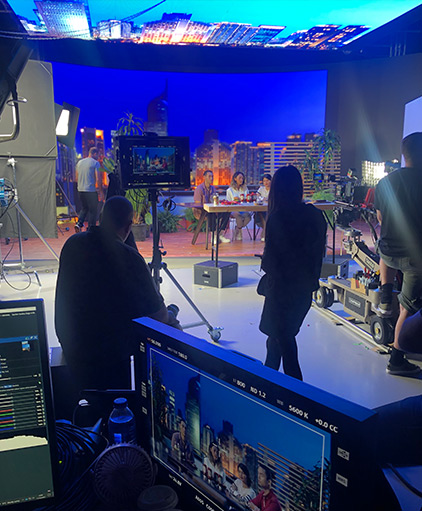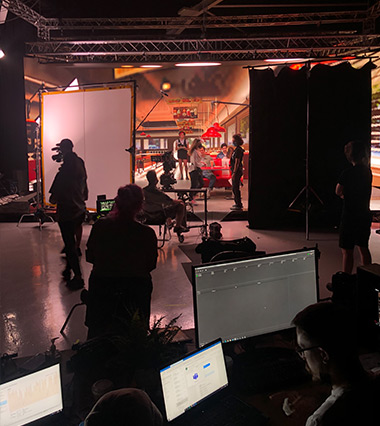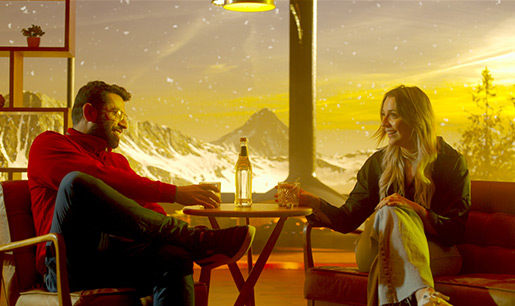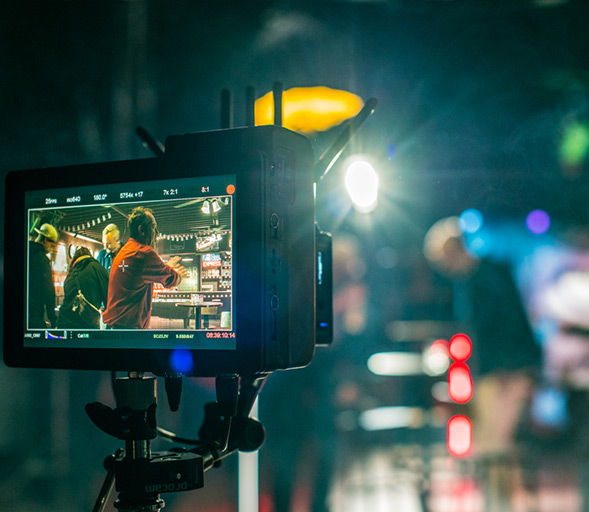What Is Virtual Production?
What is virtual production? We are glad you asked! Also known as In Camera VFX, a virtual production studio integrates real-time computer generated graphics and/or plate footage with live actors and physical props. This is done on a virtual production stage (or LED Volume) equipped with a high definition virtual production LED wall. Images displayed on the LED wall can be photorealistic CGI or simply 2d or 2.5d plates.
A virtual stage lets you craft stunning cinematic worlds without ever leaving the studio. Virtual production stages allow realistic exterior scenes to be shot in the controlled environment of an enclosed sound stage, removing problems such as bad weather, onlookers getting into shot, even unexpected noise. Virtual production in London streamlines every aspect of filmmaking for easier, more controlled, more cost-effective shoots. Step into the next era of storytelling with a VR production company that brings immersive worlds to life. Our virtual staging enhances real estate and film sets with lifelike digital environments that captivate audiences.




Our Virtual Production Services


Technology Overview
Our virtual production stages are equipped with advanced LED wall technology which allows interaction between the physical and virtual elements of a shoot in camera and in real time. This not only means that you can set your production anywhere you like, real or imagined without needing to leave our South London location, you can also reduce the amount of post-production time that your shoot will require, saving both time and money while still producing a superior end product. Essentially, virtual production transforms filmmaking by merging physical sets with digital magic in real-time.
What Makes Us Unique?
Our flexibility, adaptability and in-house expertise sets us apart from other studios. We have the capability to create entire worlds for your production allowing you to take your shoot to all corners of the globe, or across the galaxy, without ever leaving South London. This means that you also have ready access to the capital’s immense reservoir of creative, technical and acting talent. Elevate your next project with our top-tier production studio in London, equipped for both traditional and virtual shoots.

Virtual Production Studio London
What is Virtual Production? Learn how virtual studio technology transforms filmmaking with LED walls, real-time CGI, and immersive digital environments.
What Is Virtual Production?
What is Virtual Production? It is an advanced filmmaking process that merges live-action footage with computer-generated environments, all in real time, on set. Instead of traditional green screens, productions now use LED walls to display photorealistic 3D backgrounds. These are powered by game engines and rendered live, allowing actors to interact naturally with the environment as cameras roll. The technology enables filmmakers to capture final shots on set, reducing post-production work. Directors, cinematographers, and production teams can see exactly how scenes will appear while shooting, making immediate creative decisions and adjustments. This approach not only streamlines workflows but also unlocks new levels of visual storytelling.
The Evolution of Filmmaking: From Green Screens to LED Volumes
Over the past decade, the film industry has undergone a remarkable shift from static green screens to fully immersive LED Volume stages. Traditionally, green screen techniques required significant post-production to insert backgrounds and digital environments, often leading to lighting mismatches and performance challenges for actors. In contrast, LED Volume Virtual Studios place actors within lifelike, dynamic environments during filming. These LED walls wrap around the stage and display real-time visuals that respond to camera movements, providing accurate lighting, reflections, and perspective. Productions that adopt this method, including blockbuster films and high-end commercials, benefit from increased realism, more natural performances, and faster production cycles. As Virtual Production Using LED Wall technology matures, it continues to redefine how filmmakers approach storytelling.
Why Virtual Production Is Reshaping Content Creation
Virtual Production in film is transforming content creation across the entertainment and advertising industries. In a world where content demands are rising and deadlines are tightening, traditional production models often struggle to keep pace. Virtual Production Studio workflows offer a powerful alternative. By integrating real-time CGI, LED walls, and advanced camera tracking, productions can create visually stunning environments without leaving the studio. This method eliminates many of the logistical complexities associated with location shoots, such as travel costs, permits, and unpredictable weather. It also allows teams to visualise and refine creative ideas on the fly. For brands, broadcasters, and filmmakers, this means faster project delivery, greater creative flexibility, and the ability to craft unique visual experiences that captivate audiences.
Understanding Virtual Studio Technology
Virtual Studio Technology underpins the entire Virtual Production pipeline. At its core, it enables seamless interaction between physical sets, live-action performances, and digital environments rendered in real time. The key innovation lies in the use of real-time rendering engines, such as Unreal Engine Virtual Production, which generate detailed, photorealistic visuals on LED walls during filming. Camera tracking systems synchronise movement with these visuals, ensuring accurate parallax and perspective. Meanwhile, Virtual Camera Tracking captures spatial data, allowing cinematographers to frame shots as if working on a real-world set. The result is a production environment where directors can view fully composed shots during the shoot itself, making informed creative decisions and streamlining the entire production process.
What Makes a Studio “Virtual”?
A Virtual Production Studio is defined by its ability to merge physical and digital elements into a cohesive, interactive filmmaking space. Unlike traditional sound stages, these studios are equipped with high-resolution LED walls, advanced game engine software, and precision camera tracking systems. Virtual Studio Software controls the displayed environments, while Digital Studio Setup ensures all hardware and software components work in harmony. The studio becomes a dynamic stage where backgrounds shift in response to camera angles, and lighting is fully integrated with the on-screen visuals. This setup allows productions to build elaborate, photorealistic environments that evolve in real time. It also supports Virtual Set Design Tools, giving creative teams unprecedented flexibility in scene creation and shot composition.
Key Components: LED Walls, Game Engines, and Motion Capture
Successful Virtual Production relies on an intricate ecosystem of technologies working seamlessly together. LED walls serve as the visual canvas, displaying high-resolution, real-time environments that wrap around the Virtual Stage. Game engines such as Unreal Engine or Unity drive these visuals, generating photorealistic environments with advanced lighting, shading, and reflections. Motion capture and camera tracking systems ensure that actor movements and camera positions are synchronised with the virtual world, preserving spatial coherence. Instruments and VST Audio are integrated into the sound design process, enhancing audio production during shoots. XR Stage setups further expand possibilities, blending virtual and augmented environments in real time. Live Compositing Tools allow for adjustments on the fly, while Remote Production Systems enable distributed teams to collaborate effectively. Together, these components form the core of a cutting-edge Virtual Production Studio.
How Virtual Studio Technology Works
Virtual Studio Technology operates through an intricate workflow that combines hardware and software to produce real-time visual effects. LED Volume Stages display immersive environments that adjust dynamically as cameras move, thanks to precision tracking systems. Real-Time Rendering engines update visuals on the fly, ensuring that perspective, lighting, and reflections remain consistent. Virtual Instruments and VST Plugins are often used to enhance audio production during the shoot, while Studio Automation Software manages the overall system performance. On set, directors and cinematographers monitor composite shots in real time, allowing immediate feedback and creative adjustments. This approach not only improves production efficiency but also elevates the visual fidelity of the final product.
Step-by-Step Workflow from Previs to Final Shot
A typical Virtual Production workflow begins with previsualisation (previs), where scenes are designed and visualised using 3D Environment Rendering tools. Production designers collaborate with digital artists to create detailed environments, which are then imported into game engines. During the shoot, LED walls display these environments while Motion Capture and Virtual Camera Tracking ensure alignment between live-action elements and digital backgrounds. Lighting is calibrated to match the virtual scene, and real-time adjustments can be made as needed. Once principal photography is complete, minimal post-production is required, as most visual effects are captured live. This streamlined process not only saves time but also delivers more consistent and cohesive visual results.
Integrating Physical and Digital Sets Seamlessly
One of the key strengths of Virtual Production is its ability to blend physical and digital elements seamlessly. Productions often combine practical set pieces with LED-displayed environments to ground actors in the scene. For example, a partial physical set may include key props and textures, while the surrounding world is rendered digitally on the LED walls. This approach allows filmmakers to maintain tactile realism while expanding the scope of the scene beyond the physical stage. Virtual Production Tools For Broadcasters and film studios enable this level of integration, supporting everything from period dramas to sci-fi epics. By aligning physical and digital components so precisely, Virtual Production delivers immersive, photorealistic results that resonate with audiences.
Role of Lighting and Reflections in Virtual Sets
Lighting plays a pivotal role in achieving visual realism within Virtual Production. Unlike green screen workflows, where lighting must be carefully controlled to avoid colour spill, LED Virtual Production stages naturally light actors and set pieces with the displayed background. This creates accurate reflections and ambient lighting that match the virtual environment. Real-Time Virtual Studio Systems allow lighting adjustments during the shoot, providing flexibility and creative control. Reflections in costumes, props, and surfaces align perfectly with the on-screen world, eliminating the need for extensive post-production corrections. This level of realism enhances both the aesthetic quality and the believability of the final footage.
Benefits of Virtual Production for Filmmakers
Virtual Production offers transformative advantages for filmmakers, broadcasters, and content creators. The ability to visualise entire scenes in real time means that directors can make informed creative decisions on set, drastically reducing the need for post-production revisions. Final-pixel shots captured during filming provide clarity and consistency throughout the production pipeline. Virtual Production Studio environments also support flexible, iterative set design, where changes can be implemented swiftly. Additionally, elements like 360-Degree Virtual Set designs allow productions to build expansive worlds within the studio, offering limitless creative potential. As Virtual Studio Technology evolves, studios such as Quite Brilliant continue to push the boundaries of what’s possible in modern filmmaking.
Cost Efficiency and Time Savings
Producing content with Virtual Production in film significantly reduces costs compared to traditional production models. Location shoots often involve extensive travel, lodging, and logistical expenses. By using a Virtual Production Stage, filmmakers eliminate these overheads while gaining full creative control. Furthermore, the ability to capture final shots on set minimises post-production time. Real-time rendering and live compositing streamline the editing process, accelerating delivery schedules. Studios also benefit from the reusability of digital assets, which can be repurposed for multiple projects, enhancing long-term cost efficiency.
In addition to lowering travel and location costs, Virtual Production reduces the need for multiple crew call days, expensive set builds, and location resets. The flexibility of LED Virtual Production also allows multiple scenes and settings to be captured within the same day, further improving cost efficiency. Moreover, the reuse of digital assets streamlines future productions.
Enhanced Creative Flexibility
One of the standout strengths of Virtual Production is its unmatched creative flexibility. Directors and production designers can build entire worlds using Virtual Set Design Tools, limited only by imagination. Sets can be modified on the fly to match evolving creative needs, while camera angles and lighting can be adjusted in real time. This flexibility is particularly valuable for complex projects, where traditional set builds would be cost-prohibitive. Virtual Presentation Studio workflows also enable real-time audience engagement for live shows and broadcasts, further expanding creative opportunities.
Virtual Studio Software enables set designs to be modified on demand, offering unparalleled flexibility for filmmakers. Augmented Reality Graphics can be integrated in real time, enhancing both live shoots and post-production options. This adaptive workflow empowers directors to experiment with bold creative choices without the constraints of traditional production.
Remote Collaboration Opportunities
Modern Virtual Studio For Live Shows and film productions support remote collaboration through cloud-based tools. Creative teams, visual effects artists, and clients can participate in real time from anywhere in the world. Real-Time Global Collaboration with Cloud Workflows allows directors to review scenes, adjust assets, and provide feedback without being physically present. This approach supports distributed production teams and accommodates the increasing demand for flexible working arrangements in the entertainment industry.
Remote Production Systems make Virtual Production highly adaptable for hybrid and distributed teams. Directors, VFX supervisors, and clients can participate in real-time reviews from remote locations. This capability is particularly valuable for global brands and productions managing talent and crew across different regions.
Virtual Production vs Traditional Filmmaking
Comparing Virtual Production to traditional filmmaking highlights key differences in process and output. Conventional shoots often rely on green screens, with digital environments added in post. This can lead to mismatched lighting and limited creative feedback during filming. In contrast, Virtual Production integrates digital and physical elements on set, providing immediate visual feedback and more natural performances. Virtual Broadcast Studio Technology enhances this workflow for live events, allowing seamless integration of real-time graphics.
Practical Effects vs Digital Environments
Virtual Production does not eliminate practical effects — it elevates their role within a hybrid workflow. Physical props, costumes, and foreground set pieces provide crucial tactile realism for actors and audiences alike. Meanwhile, digital environments displayed on LED walls extend the world beyond the stage. For example, a small interior set can appear to exist within a vast cityscape or alien world. Green Screen Alternatives struggle to match the seamless lighting and reflections that LED walls deliver. Additionally, Virtual Newsroom Sets and Virtual Broadcast Studio Technology enable live productions to incorporate sophisticated digital environments while retaining authentic studio elements.
Comparing Workflows: Pre-production to Post
The Virtual Production workflow offers significant efficiencies across all phases of production. During pre-production, teams use Virtual Location Scouting and previs tools to plan scenes. On set, LED Virtual Production stages allow for live capture of complex environments. Post-production is streamlined, as final-pixel shots reduce the need for extensive visual effects work. This integrated process shortens production timelines and enhances creative consistency from start to finish.
The workflow of Virtual Production is designed to streamline every phase of filmmaking. During pre-production, teams engage in Virtual Location Scouting and previs, building detailed 3D environments with Virtual Set Design Tools. Production phases benefit from real-time feedback, where camera and lighting adjustments can be made dynamically on set. Post-production is often shortened, as final-pixel shots require minimal compositing. This integrated pipeline delivers consistent visual quality while reducing turnaround time, particularly valuable for commercial and broadcast projects.
Production Timelines Compared
Production timelines for Virtual Production projects are often shorter than those for traditional shoots. Pre-production benefits from rapid iteration of digital sets, while real-time rendering eliminates the need for lengthy post-production compositing. Filmmakers can complete projects faster, meeting the demands of modern content cycles. This efficiency is particularly valuable for broadcast and commercial productions, where speed to market is critical.
Production timelines in Virtual Production are consistently more efficient than traditional workflows. Pre-production is accelerated through the reuse of virtual assets and real-time set reviews. Shooting days are optimised, as Virtual Production LED Wall technology allows multiple environments to be captured without changing physical locations. In post-production, the need for complex compositing is reduced, enabling faster delivery to clients and distributors.
Environmental and Logistical Considerations
Virtual Production offers notable environmental benefits. By reducing the need for travel and physical set construction, productions can lower their carbon footprint. LED Volume Stages enable filmmakers to shoot diverse locations without leaving the studio, cutting emissions from transportation and on-location power usage. Additionally, Digital Set Extensions minimise material waste by reducing the need for temporary set builds. As sustainability becomes a growing priority in the industry, Virtual Production presents a forward-thinking solution.
Virtual Production offers clear environmental benefits by minimising the need for travel, large-scale set builds, and on-location shoots. By consolidating production within a studio, emissions related to transportation and logistics are significantly lowered. Live Streaming Studio Design also supports remote participation, reducing crew travel. This sustainable approach aligns with industry-wide efforts to adopt greener production practices, helping studios lower their carbon footprint while delivering visually stunning results.
Technology Behind the Scenes
Behind every successful Virtual Production lies an intricate blend of advanced technologies. From LED walls and game engines to camera tracking and live compositing, these systems work in concert to create seamless, immersive environments. Understanding how these tools function together is key to appreciating the power of Virtual Studio Technology.
LED Wall Technology Explained
LED Wall Technology is central to Virtual Production workflows. High-resolution LED panels display dynamic, photorealistic backgrounds that adjust in real time. These panels wrap around the Virtual Stage, creating immersive environments with accurate lighting and perspective. Virtual Production LED Wall setups enable filmmakers to shoot complex scenes with unparalleled visual fidelity, transforming how stories are brought to life.
Modern LED walls offer unmatched brightness, colour accuracy, and pixel density, creating lifelike environments that actors can perform within. Integrated systems synchronise the LED displays with camera movement, preserving correct perspective. LED walls also emit natural light onto the scene, enhancing reflections and ambient lighting.
Real-Time CGI and Game Engines (Unreal, Unity)
Real-time CGI powered by game engines such as Unreal Engine and Unity drives the visual experience on Virtual Production stages. These engines render detailed 3D environments on the fly, synchronising with camera movements and lighting. Unreal Engine Virtual Production has become an industry standard, delivering stunning visuals with frame-perfect accuracy. The integration of Real-Time Rendering enhances the creative process, allowing directors to see their vision unfold during the shoot.
Game engines like Unreal Engine Virtual Production support complex 3D asset creation, procedural animation, and physics simulations. Real-Time Rendering allows immediate visual updates based on camera movements, giving directors the flexibility to adjust scenes live. VST ST Audio and Instruments can also be incorporated, enriching the production’s sound design.
Motion Capture and Camera Tracking Systems
Motion capture and Virtual Camera Tracking are essential for aligning live-action elements with virtual environments. These systems track actor movements and camera positions with millimetre accuracy, ensuring seamless interaction between physical and digital components. Live Compositing Tools further refine the visual output, enabling real-time adjustments to maintain continuity and visual coherence. Together, these technologies create immersive, photorealistic experiences that push the boundaries of cinematic storytelling.
Advanced camera tracking systems capture positional data with sub-millimetre accuracy. Combined with motion capture, this ensures actors’ movements interact naturally with the digital environment. Live Compositing Tools further refine this integration, supporting seamless transitions between real and virtual elements in every shot.
The Future of Virtual Studio Technology
Virtual Studio Technology is advancing rapidly. Innovations in AI and Machine Learning Integration are enabling more sophisticated real-time effects, while Virtual Reality Production Tools enhance previsualisation and scene planning. The growth of AR And VR Studio Production is opening new possibilities for interactive experiences, live shows, and immersive media. Real-Time Global Collaboration with Cloud Workflows allows creative teams to work across continents, accelerating production. As demand rises for engaging, immersive content, Virtual Production is expanding into sectors such as gaming, live broadcast, and the Metaverse. Studios like Quite Brilliant are leading this evolution, continuously pushing the limits of what Virtual Production in film can achieve.
Emerging technologies such as AI-driven content creation, adaptive lighting, and volumetric capture are poised to transform Virtual Production further. The integration of AR And VR Studio Production will unlock new storytelling formats. As platforms evolve, Virtual Production Tools For Broadcasters will expand, driving innovation across both entertainment and live events.
Frequently Asked Questions
What equipment is used in a virtual production studio?
A Virtual Production Studio typically features LED walls, real-time rendering engines, motion capture systems, and Virtual Camera Tracking. Additional tools include Virtual Studio Software, Digital Studio Setup components, and Studio Automation Software. Together, these create a seamless, interactive production environment.
Are LED walls better than green screens?
LED Virtual Production walls provide several advantages over green screens. They offer accurate reflections, natural lighting, and a real-time view of the scene. Actors can engage with immersive backgrounds, improving performance, while post-production needs are significantly reduced.
What are the benefits of virtual production over traditional methods?
Virtual Production saves time, reduces costs, and enhances creative flexibility. It eliminates many logistical challenges of location shoots, supports Real-Time Virtual Production, and allows directors to make live adjustments. The process also reduces post-production timelines by capturing final shots on set.
What is the difference between virtual production and CGI?
CGI typically involves adding digital elements in post-production. In contrast, Virtual Production integrates real-time CGI with live-action on set, using LED Volume Stages and real-time rendering. This approach allows directors to see the final composite during filming, improving creative control.
Which movies or shows have used virtual production?
Many high-profile productions now use Virtual Production. Major films, series, and commercials leverage LED Volume Virtual Studio setups. The Mandalorian famously showcased the power of this technology, and many studios—including Quite Brilliant—adopt it for cutting-edge storytelling.
How much does it cost to set up a virtual studio?
Costs vary depending on the size of the Virtual Production Stage, equipment specifications, and project requirements. Studios like Quite Brilliant offer flexible solutions, from short-term rentals to full-scale Digital Studio Setup packages, making Virtual Production accessible for a range of budgets.
Is virtual production suitable for small studios or independent filmmakers?
What role does Unreal Engine play in virtual studio technology?
Unreal Engine Virtual Production drives real-time rendering on LED walls. It powers photorealistic environments, supports interactive lighting, and ensures precise synchronisation with camera movement. Its flexibility makes it a cornerstone of modern Virtual Production workflows across film, broadcast, and live shows.
What is the role of real-time CGI in virtual production?
Real-time CGI is central to Virtual Production. Game engines render 3D environments live, responding to camera angles and lighting. This allows directors to capture final shots on set, with Real-Time Virtual Studio Systems delivering unmatched visual fidelity and creative control.
Can virtual production be used for live broadcasts or events?
What are LED volume stages, and how are they used?
An LED Volume Stage consists of large LED walls that display immersive, dynamic backgrounds. Filmmakers use these to create virtual environments during live shoots. LED Volume Stages at Quite Brilliant, for example, merge Real-Time Rendering, Virtual Cinematography, and live-action for stunning results.
Do filmmakers still use physical sets in virtual production?
Yes, physical elements remain important. Productions often combine practical props and set pieces with digital backgrounds. This hybrid approach delivers tactile realism, with LED Virtual Production enhancing creative scope. Virtual Production Tools For Broadcasters and filmmakers support seamless integration of physical and digital components.
